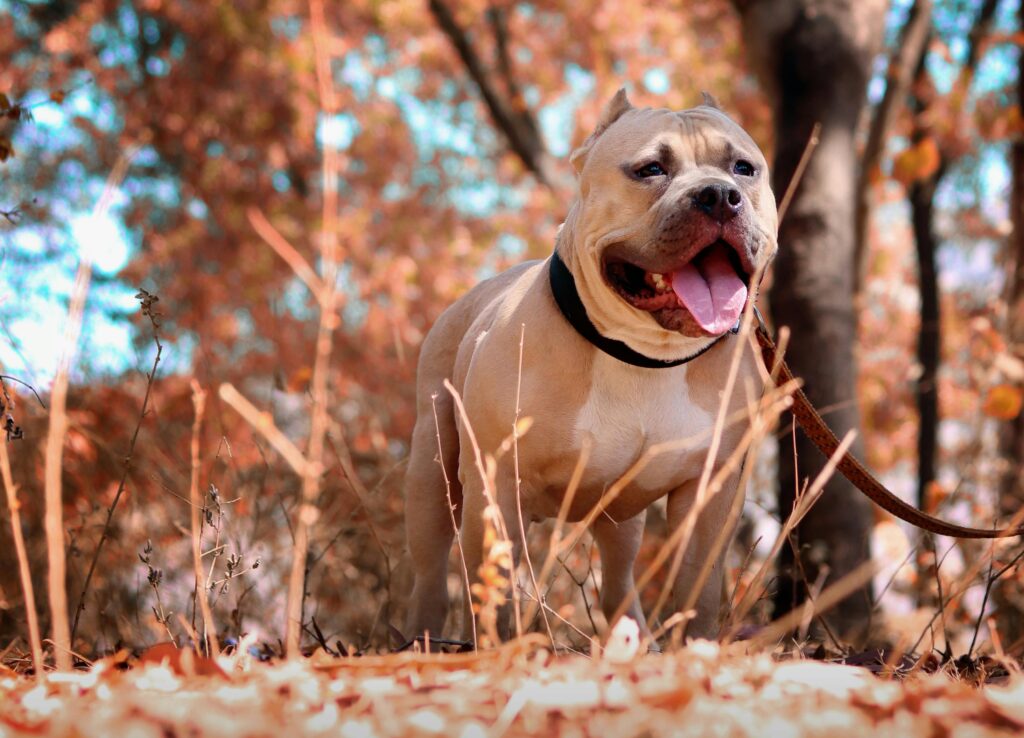| Summary: Pitbulls grow rapidly in their first year. Newborns weigh about 1 lb, reaching 15–30 lbs by 4 months, and 30–60 lbs by 12 months. Males tend to be heavier than females. Monitoring weight by age ensures proper development and early detection of health or nutritional issues. |
Pit Bulls are known for their muscular build, strength, and agility. Whether you’re a Pit Bull owner or considering adopting one, understanding their growth patterns and weight progression is vital for their health and development. This detailed PitBull weight chart by age will provide you with valuable insights into what to expect in terms of weight and size from birth through adulthood. Tracking your dog’s weight is an essential part of ensuring they are on the right growth path and receiving proper care.
Check out the best dog collars for Border Collie to find durable, stylish, and comfortable options for your active dog.
In this article, we will break down the typical weight ranges of Pit Bulls at different stages of their life, highlight key factors influencing their growth, and provide tips for ensuring your dog’s development is healthy and balanced.
Blog Highlights
ToggleOverview of Pit Bull Growth Stages
Pit Bull puppies grow quickly during their first year, with the most significant growth occurring in the first 6 months. After that, their growth rate slows down, but they will continue to develop muscle mass and strength throughout their second year. Understanding how your Pit Bull grows in terms of weight and size will help you make informed decisions about feeding, exercise, and care.

Generally, Pit Bulls reach their full adult weight by 18 to 24 months. However, variations in weight are common due to factors such as genetics, diet, and exercise. Pit Bull owners should aim for a healthy weight that promotes overall well-being and physical fitness for their dog, avoiding both underweight and overweight conditions.
PitBull Weight Chart by Age
Below is a comprehensive weight chart outlining the expected weight of Pit Bulls at different stages of their life. These values are approximate, as each dog is unique and will grow at its own pace depending on its genetics, diet, and other factors. For guidance on choosing the right collar size for an Airedale puppy, check out this detailed guide.

| Age | Male Pit Bull Weight (lbs) | Female Pit Bull Weight (lbs) |
| 2 Months | 6 – 8 lbs | 5 – 7 lbs |
| 3 Months | 10 – 12 lbs | 9 – 11 lbs |
| 4 Months | 15 – 18 lbs | 14 – 16 lbs |
| 5 Months | 20 – 25 lbs | 18 – 22 lbs |
| 6 Months | 25 – 35 lbs | 22 – 30 lbs |
| 7 Months | 30 – 40 lbs | 27 – 35 lbs |
| 8 Months | 35 – 45 lbs | 30 – 40 lbs |
| 9 Months | 38 – 50 lbs | 32 – 42 lbs |
| 10 Months | 40 – 55 lbs | 35 – 45 lbs |
| 11 Months | 45 – 60 lbs | 38 – 50 lbs |
| 12 Months | 50 – 65 lbs | 40 – 55 lbs |
| 18 Months | 55 – 75 lbs | 45 – 60 lbs |
| 24 Months | 60 – 85 lbs | 50 – 65 lbs |
Growth Phases and Key Milestones
To fully understand the significance of the above weight chart, it’s helpful to look at the various growth phases Pit Bulls go through and the factors influencing their weight gain at each stage.
1. Birth to 2 Months: Early Development
At birth, Pit Bull puppies are typically very small, weighing only around 1-2 pounds. They rely entirely on their mother’s milk for nourishment. By the time they are 2 months old, they have grown significantly, with males typically weighing between 6 and 8 pounds, while females weigh between 5 and 7 pounds.
At this stage, puppies are still developing their basic motor skills and will begin to show curiosity about their environment. They will gradually begin to eat solid food as they approach 8 weeks of age.
2. 2 to 4 Months: Rapid Growth
Between 2 to 4 months, Pit Bull puppies experience a rapid growth spurt. This is a critical period for muscle and bone development, and puppies should be receiving a diet high in protein and fats to support their physical growth. During this period, male Pit Bulls can weigh anywhere from 10 to 18 pounds, while females typically range from 9 to 16 pounds.
Puppies in this stage are highly energetic and are still in the process of developing social skills. They are also beginning basic training and will start to understand commands and house rules. It’s also a good time to begin socializing them with other dogs and environments.
3. 4 to 6 Months: Building Muscle Mass
By the time your Pit Bull reaches 4 to 6 months, they are likely becoming more muscular, with increased bone density and strength. Their weight will be climbing significantly during this period, with male Pit Bulls reaching anywhere from 25 to 35 pounds and females weighing 22 to 30 pounds at 6 months.
This is a crucial time to focus on a balanced diet and provide regular exercise to build strong muscles without overtaxing the developing joints. This stage is also the time when your dog will start to exhibit its true personality and may show signs of independence.
4. 6 to 12 Months: Transitioning to Adolescence
From 6 to 12 months, your Pit Bull will continue to gain weight, but the rate of growth will begin to slow down. At 12 months, males typically weigh between 50 and 65 pounds, while females weigh between 40 and 55 pounds. This is a period of transition as the dog matures from a puppy into an adolescent, and you may notice changes in behavior, energy levels, and training needs.
Although they are getting larger and stronger, your Pit Bull’s growth is still not complete, and they will continue to build muscle mass as they approach adulthood. This is also the time when many Pit Bulls experience a growth spurt, and they may become slightly clumsier due to their rapidly growing bodies.
5. 12 to 18 Months: Full Development
By 12 months, your Pit Bull is transitioning to a young adult dog. The growth rate continues to slow down, but they are still developing muscle mass and physical strength. At this stage, males typically weigh between 55 to 75 pounds, and females will be between 45 to 60 pounds.

This is the time when your dog’s physical appearance starts to fully mature, and you will notice a leaner, more athletic build. Your Pit Bull may also reach their full height by 18 months, although some dogs may continue to grow in muscle mass until they are 2 years old.
6. 18 to 24 Months: Reaching Full Adult Size
By 18 to 24 months, your Pit Bull will be fully grown in terms of weight and muscle. At this stage, males can weigh between 60 and 85 pounds, while females generally weigh between 50 and 65 pounds.
However, muscle development can continue well into their second year of life. At this point, your dog should be at their peak physical condition, and their behavior will also become more stable as they mature. For insights on whether Airedales are good off-leash, explore this comprehensive article.
Factors That Influence Pit Bull Growth and Weight
While the weight chart provides a useful guideline, it’s important to remember that several factors can influence your Pit Bull’s weight. Genetics, diet, exercise, and health all play significant roles in how your dog will grow. Let’s take a look at these factors in detail:

1. Genetics
The genetic makeup of your Pit Bull will have a huge impact on its size and weight. Dogs from larger bloodlines or champion show dog lines may grow to be heavier and more muscular than those from smaller working or companion bloodlines. This genetic variation explains why some Pit Bulls may weigh more or less than the average at various stages of development.
2. Diet and Nutrition
Proper nutrition is crucial for your Pit Bull’s growth. A balanced diet with high-quality protein and fats is essential for healthy weight gain. Puppies require more calories than adults due to their rapid growth rate. Feeding your Pit Bull a nutrient-rich, high-protein food designed for puppies will ensure they are getting the nutrients they need for proper growth.
It’s important to avoid overfeeding, as obesity can lead to serious health issues later on, such as joint problems and heart disease.
3. Exercise
Regular exercise is essential for building muscle and bone strength in your Pit Bull. Proper physical activity helps your dog maintain a healthy weight and promotes muscle growth. However, excessive or high-impact exercise at a young age can put unnecessary strain on their developing joints. It’s essential to offer age-appropriate exercise and gradually increase intensity as your dog matures.
4. Health and Medical Care
Your Pit Bull’s overall health will influence their weight and growth rate. Dogs that suffer from health issues such as parasites, malnutrition, or infections may not gain weight as quickly as healthy puppies. Regular veterinary check-ups and preventive care are crucial to monitor growth and ensure that your dog remains on track.

Discover the benefits of using a harness by reading this guide on should a Collie wear a harness.
Conclusion
Tracking your Pit Bull’s weight is an important part of ensuring they are developing properly and staying healthy. By understanding the expected weight at each stage of their life, you can make informed decisions about their diet, exercise routine, and overall care. Keep in mind that individual variations exist, and factors such as genetics, nutrition, and exercise will all contribute to your dog’s growth.
If you notice significant weight deviations from the standard ranges provided in this pitbull weight chart by age, it’s always a good idea to consult your veterinarian to ensure your Pit Bull is on the right track. With proper care, your Pit Bull will grow into a strong, healthy, and happy adult.





